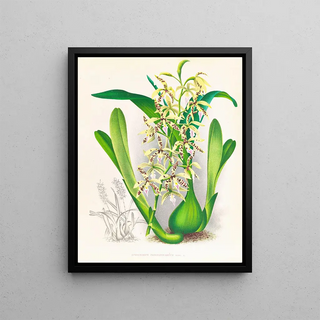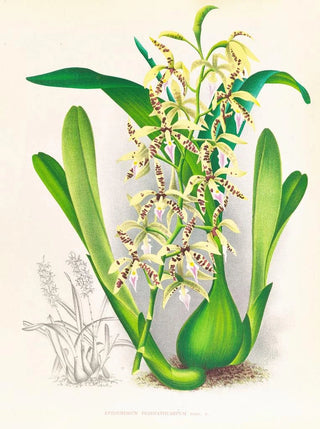Art print | Épidendrum prismatocarpum - Jean Jules Linden


View from behind

Frame (optional)
Épidendrum prismatocarpum art print - Jean Jules Linden – Captivating introduction
The artwork "Épidendrum prismatocarpum" by Jean Jules Linden stands as a true ode to the beauty of nature. Capturing the very essence of orchids, this iconic piece transports us into a universe where the delicacy of flowers blends with a rich palette of colors. Linden, botanist and artist, has immortalized this exotic plant with a precision and artistic sensibility that transcend mere botanical depiction. Through this art print, viewers are invited to contemplate not only the splendor of flora but also the harmony that exists between humans and nature.
Style and uniqueness of the art print
Linden's work is distinguished by its striking realism and meticulous approach. Every petal, every stem is depicted with careful detail, revealing the complexity of forms and textures. The color palette chosen by the artist evokes natural light, paying homage to the brilliance of flowers in their native habitat. This realism is not just a simple imitation of reality; it is a poetic interpretation that invites deep contemplation. The composition, balanced and harmonious, allows the art print to flourish visually while maintaining an intimate connection with botany. Thus, "Épidendrum prismatocarpum" becomes an open window to a world where natural beauty is celebrated in all its splendor.
The artist and his influence
Jean Jules Linden, born in 1817, is an essential figure of the 19th century, at the crossroads of science and art. Trained as a botanist, he dedicated his life to the study of exotic plants, traveling around the world to collect specimens. His work reflects this passion, blending scientific rigor with artistic sensitivity. Linden was not merely an observer; he was also a visionary, capable of perceiving hidden beauty in every detail. His influence endures today, inspiring many artists and botanists who seek to capture the magic of nature. Through his illustrations, he paved the way for a new appreciation of botany, encouraging the public to see plants not only as objects of study but as

Matte finish

View from behind

Frame (optional)
Épidendrum prismatocarpum art print - Jean Jules Linden – Captivating introduction
The artwork "Épidendrum prismatocarpum" by Jean Jules Linden stands as a true ode to the beauty of nature. Capturing the very essence of orchids, this iconic piece transports us into a universe where the delicacy of flowers blends with a rich palette of colors. Linden, botanist and artist, has immortalized this exotic plant with a precision and artistic sensibility that transcend mere botanical depiction. Through this art print, viewers are invited to contemplate not only the splendor of flora but also the harmony that exists between humans and nature.
Style and uniqueness of the art print
Linden's work is distinguished by its striking realism and meticulous approach. Every petal, every stem is depicted with careful detail, revealing the complexity of forms and textures. The color palette chosen by the artist evokes natural light, paying homage to the brilliance of flowers in their native habitat. This realism is not just a simple imitation of reality; it is a poetic interpretation that invites deep contemplation. The composition, balanced and harmonious, allows the art print to flourish visually while maintaining an intimate connection with botany. Thus, "Épidendrum prismatocarpum" becomes an open window to a world where natural beauty is celebrated in all its splendor.
The artist and his influence
Jean Jules Linden, born in 1817, is an essential figure of the 19th century, at the crossroads of science and art. Trained as a botanist, he dedicated his life to the study of exotic plants, traveling around the world to collect specimens. His work reflects this passion, blending scientific rigor with artistic sensitivity. Linden was not merely an observer; he was also a visionary, capable of perceiving hidden beauty in every detail. His influence endures today, inspiring many artists and botanists who seek to capture the magic of nature. Through his illustrations, he paved the way for a new appreciation of botany, encouraging the public to see plants not only as objects of study but as






